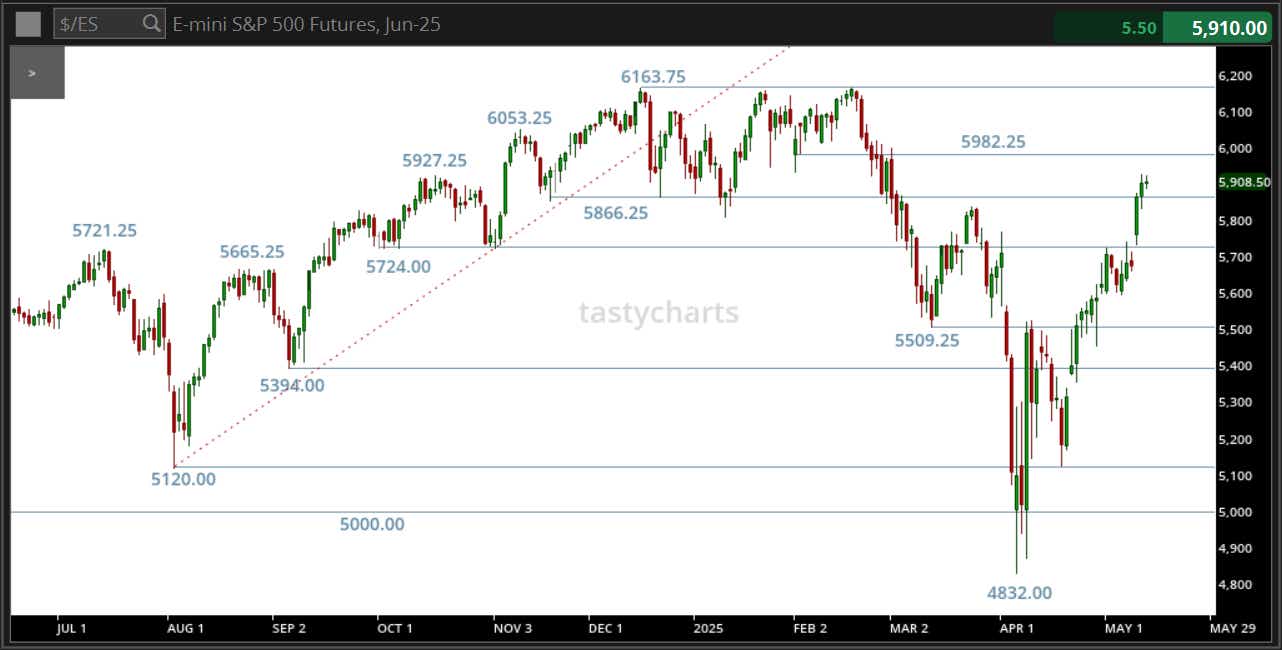Stocks Stall as Markets Eye US Retail Sales Data for a Growth Check

Stocks Stall as Markets Eye US Retail Sales Data for a Growth Check
By:Ilya Spivak
Will consumers give the stock market something new to celebrate?
- Wall Street is in wait-and-see mode amid a lull high-stakes news flow.
- As trade war recedes into the background, growth trends are in view.
- US retail sales figures are now in focus for a check on recession risk.
A pause in headline-grabbing news flow left stock markets rudderless after two days of convincing gains. The bellwether S&P 500 is trading flat heading into the closing bell. The tech-tilted Nasdaq 100 has fared a little better, posting a modest gain, while the small-cap Russell 2000 is underperforming with a modest intraday loss.
Equities stormed higher at the start of the week after rosy pronouncements from US officials following blitz trade negotiations with a Chinese delegation in Geneva, Switzerland over the weekend. The talks produced a sharp climb down on tariff rates from both sides for a 90-day window to carve out a lasting deal.
Are stock markets ready to start thinking about the economy again?
Refreshingly “normal” US inflation data helped keep the markets disposition cheerful. The figures pointed to a gradual cooling of service-sector price pressure – a welcome sign for Federal Reserve officials – alongside the glaring absence of a surge in goods inflation amid the Trump administration’s rapid-fire trade war.

Wall Street has now erased all of the losses sustained amid the panic in April when markets recoiled in horror at the sight of President Trump’s “Liberation Day” tariff plan. It seemed to imply that the U.S. was intent on cataclysmic self-harm with a policy that tried to break the foundational role of US Treasury bonds and the dollar in global finance.
This may bring a conversation about the business cycle back to the forefront. Worries about slowing economic growth amid sharp drops in business and consumer confidence drove the start of the stock market selloff in mid-February. With the trade war seemingly shifted to the background, a status check on recession risk seems due.
US retail sales in focus: will consumers keep front-running tariffs?
With that in mind the spotlight turns to US retail sales data. It is expected to show that receipts growth stalled last month after a 1.5% jump in March, marking the largest increase since January 2023. A surge in purchases of motor vehicles and auto parts drove the upswell, which probably reflected a rush to front-run tariffs due to hit that sector.

US gross domestic product (GDP) data revealed a dramatic jump in imports and inventories as businesses anticipating tariff hikes rushed to stock up at lower prices. Meanwhile, S&P Global purchasing manager index (PMI) data revealed a brisk pickup in economic activity growth in the consumer goods sector last month.
If this boils down to another month of anticipatory buying, April’s retail sales print is likely to overshoot forecasts. Stocks are likely to cheer in this scenario, reasoning that tariff policy cliffhangers in July and August at the expiration of 90-day pauses for reciprocal and China-facing tariffs will keep uptake healthy in the interim.
Alternatively, a soft result may signal that consumers have exhausted their desire to pre-buy ahead of tariffs. A preview of such a scenario appeared in the same first-quarter GDP report, revealing the slowest growth in household consumption in almost two years. Stocks may lurch lower if such an outcome revives recession fears.
Ilya Spivak, tastylive head of global macro, has 15 years of experience in trading strategy, and he specializes in identifying thematic moves in currencies, commodities, interest rates and equities. He hosts Macro Money and co-hosts Overtime, Monday-Thursday. @Ilyaspivak
For live daily programming, market news and commentary, visit #tastylive or the YouTube channels tastylive (for options traders), and tastyliveTrending for stocks, futures, forex & macro.
Trade with a better broker, open a tastytrade account today. tastylive, Inc. and tastytrade, Inc. are separate but affiliated companies.
Options involve risk and are not suitable for all investors. Please read Characteristics and Risks of Standardized Options before deciding to invest in options.
tastylive content is created, produced, and provided solely by tastylive, Inc. (“tastylive”) and is for informational and educational purposes only. It is not, nor is it intended to be, trading or investment advice or a recommendation that any security, futures contract, digital asset, other product, transaction, or investment strategy is suitable for any person. Trading securities, futures products, and digital assets involve risk and may result in a loss greater than the original amount invested. tastylive, through its content, financial programming or otherwise, does not provide investment or financial advice or make investment recommendations. Investment information provided may not be appropriate for all investors and is provided without respect to individual investor financial sophistication, financial situation, investing time horizon or risk tolerance. tastylive is not in the business of transacting securities trades, nor does it direct client commodity accounts or give commodity trading advice tailored to any particular client’s situation or investment objectives. Supporting documentation for any claims (including claims made on behalf of options programs), comparisons, statistics, or other technical data, if applicable, will be supplied upon request. tastylive is not a licensed financial adviser, registered investment adviser, or a registered broker-dealer. Options, futures, and futures options are not suitable for all investors. Prior to trading securities, options, futures, or futures options, please read the applicable risk disclosures, including, but not limited to, the Characteristics and Risks of Standardized Options Disclosure and the Futures and Exchange-Traded Options Risk Disclosure found on tastytrade.com/disclosures.
tastytrade, Inc. ("tastytrade”) is a registered broker-dealer and member of FINRA, NFA, and SIPC. tastytrade was previously known as tastyworks, Inc. (“tastyworks”). tastytrade offers self-directed brokerage accounts to its customers. tastytrade does not give financial or trading advice, nor does it make investment recommendations. You alone are responsible for making your investment and trading decisions and for evaluating the merits and risks associated with the use of tastytrade’s systems, services or products. tastytrade is a wholly-owned subsidiary of tastylive, Inc.
tastytrade has entered into a Marketing Agreement with tastylive (“Marketing Agent”) whereby tastytrade pays compensation to Marketing Agent to recommend tastytrade’s brokerage services. The existence of this Marketing Agreement should not be deemed as an endorsement or recommendation of Marketing Agent by tastytrade. tastytrade and Marketing Agent are separate entities with their own products and services. tastylive is the parent company of tastytrade.
tastyfx, LLC (“tastyfx”) is a Commodity Futures Trading Commission (“CFTC”) registered Retail Foreign Exchange Dealer (RFED) and Introducing Broker (IB) and Forex Dealer Member (FDM) of the National Futures Association (“NFA”) (NFA ID 0509630). Leveraged trading in foreign currency or off-exchange products on margin carries significant risk and may not be suitable for all investors. We advise you to carefully consider whether trading is appropriate for you based on your personal circumstances as you may lose more than you invest.
tastycrypto is provided solely by tasty Software Solutions, LLC. tasty Software Solutions, LLC is a separate but affiliate company of tastylive, Inc. Neither tastylive nor any of its affiliates are responsible for the products or services provided by tasty Software Solutions, LLC. Cryptocurrency trading is not suitable for all investors due to the number of risks involved. The value of any cryptocurrency, including digital assets pegged to fiat currency, commodities, or any other asset, may go to zero.
© copyright 2013 - 2025 tastylive, Inc. All Rights Reserved. Applicable portions of the Terms of Use on tastylive.com apply. Reproduction, adaptation, distribution, public display, exhibition for profit, or storage in any electronic storage media in whole or in part is prohibited under penalty of law, provided that you may download tastylive’s podcasts as necessary to view for personal use. tastylive was previously known as tastytrade, Inc. tastylive is a trademark/servicemark owned by tastylive, Inc.